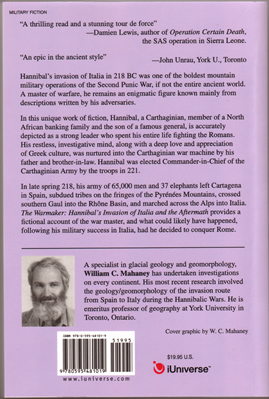 |
| The Warmaker |
|
Available at Amazon.com |
by Bill
Mahaney Available at Amazon.com ‘The Warmaker,’ as narrative fiction, follows from detailed analysis of the environmental aspects of one of the greatest feats of military history—the alpine invasion of Italia. The invasion itself, known mostly from documentation left to us from Roman writers, has led to the postulation of one of the great questions of antiquity, one that historians have attempted to answer mostly from the comfort of armchairs — what was Hannibal’s actual route across the Alps? Field work carried out by Mahaney, and a close group of associates, led to field investigations along the entire invasion route from Iberia to the Po River Plains of Northern Italy. Aside from the scientific aspects — field examination, sample collection and lab analysis — close examination of environmental parameters and actual experience on the ground led to a reconstruction — a fictional account of what Hannibal actually felt as he organized and carried out what arguably is the most unorthodox mountain military operation of all time. The cover view shown at left is to the east from below the Col de la Traversette at 2800 meters above the sea looking out into Italia towards Milano. The rock outcrops are festooned with lichens, the orange species fertilized by birds and lichens. A massive stratus cloud hovers off in the distance and below a laced pattern of rock and snow stretches off towards timberline at 1800 meters elevation. In fall 218 BC the Punic Army under Hannibal crossed over this col in one of the most ambitious and unorthodox military operations of all time. Within a month as winter closed in Hannibal reformed his army and prepared to meet the legions of Publius Cornelius Scipio on the Po River Plains. Hannibal opened a northern front in the Second Punic War, changing the military center of gravity, and for years the Punic Army roamed up and down the peninsula inflicting one grievous defeat after another on the Romans. This is the backdrop that influenced the thinking of Hannibal Barca as he wrestled with Roman domination of the Mediterranean, weighing decisions that would rock the Mediterranean World. What strategic model promised Carthage the possibility of a triumph over Rome? Would a naval invasion of Sicily succeed now, even though it failed in the first war? Would an invasion of Italia across the Alps lead to the collapse and defeat of Rome? These were some of the questions Hannibal faced while pondering his strategic objectives after his rapid accession to command of the Carthaginian Army. What would Rome do? What would the Carthaginian Suffete do? What would you do if you were Hannibal? And this was Hannibal, a man driven to plan one of the most ambitious military operations of all time, the alpine invasion of Italia in 218 BC. A man whose demons guided him in pursuit of his enemies, hunting with the ruthlessness of a hired killer, planning each disposition on a parabolic chessboard with far more than sixty-four squares. Hannibal foretold Roman reactions to his every move, and lured one field army after another into no-win situations, often with devastating results. This was a commander with a magnetic personality who led and mesmerized a polyglot force of mercenaries, soldiers he moulded into the Carthaginian Corps, one of the most proficient fighting forces of all time. In The Warmaker, the legendary trek across the Alps is recounted with as much historically-documented detail as possible, interwoven with fictional events as they might have happened and fictional characters as they may have interacted with Hannibal. Nowhere in the military history of the world B even considering the monumental exploits of Belisarius, Charlemagne, and Napoléon; German mountain division (Alpenkorps) operations of WWI and II; historical record of the U.S. Tenth Mountain Division in the Aleutians and in northern Italy during WWII; and Patton’s epic march to relieve Bastogne — has there ever been a military mission to match Hannibal=s epic march and its aftermath, a tactical operation studied by legions of military historians. This first piece of narrative fiction on Hannibal is followed by the factual story of the invasion —W.C. Mahaney, 2008. ‘Hannibal’s Odyssey: Environmental Background to the Alpine Invasion of Italia,’ Gorgias Press, Piscataway, NJ, 221 pp. ISBN 978-1-59333-951-7. |
||
 |
|||
